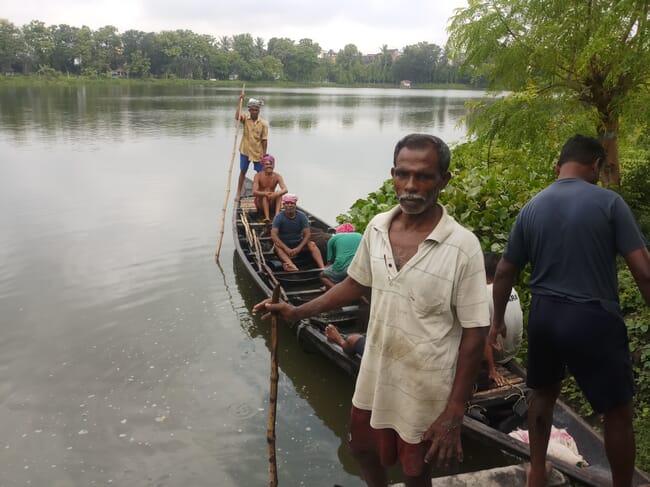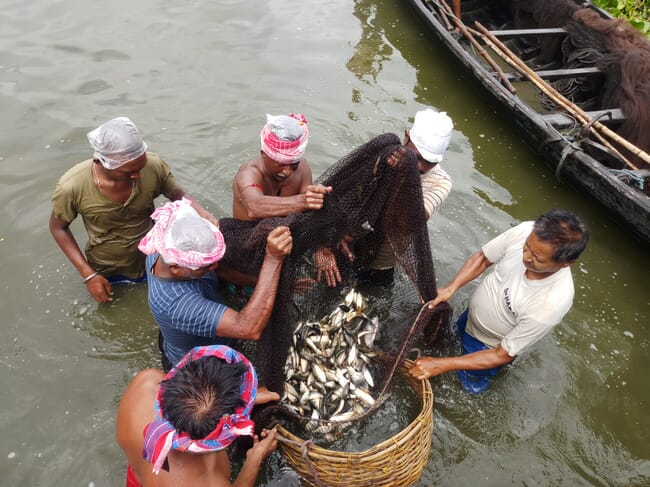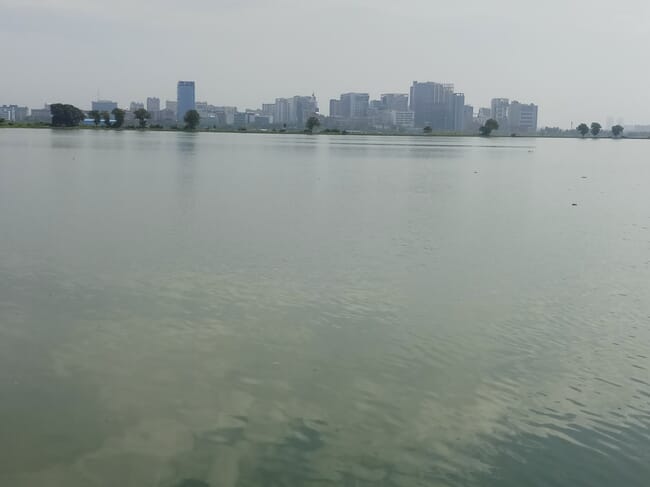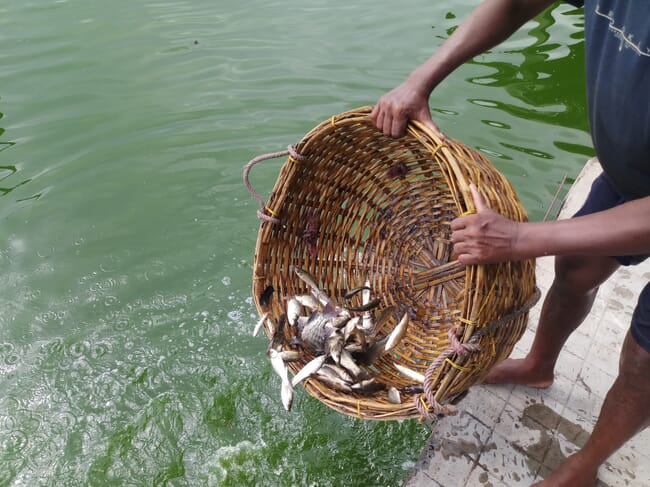Bijay Mondal has been a fish farmer and fisherman in the East Kolkata Wetlands, in the Indian state of West Bengal, for over 30 years. The 61-year-old catches fish in a lagoon which has the rare distinction of being part of the largest organic sewage treatment system in the world.

© Gurvinder Singh
Bijay is employed as a labourer in a co-operative fish hatchery which stocks its fingerlings into the wetlands where nutrients in the wastewater allow them to grown to commercial size and they are harvested by fishermen. He earns Rs ₹200 (around £2) after toiling for six to seven hours every day at the hatchery. His job involves catching the small fish and then transferring them into the bigger ponds; they are then collected by other sets of fishermen after they grow to around 200g-250g. The maximum size of the fish in the wetlands goes up to 300g as fish are caught daily here. Around 16 tonnes of fish are stocked into the ponds every two months.
Cultivating fish in untreated wastewater offers employment to nearly 50,000 people like Bijay, who both work as daily labourers and catch local fish species like silver carp, common carp, mrigal, rohu and catla in their time off.
These fish, which are essentially reared on household sewage water, with no additional feed being provided, are being consumed by the citizens of Kolkata, the state capital of West Bengal, and its suburbs.
Yet Bijay sounds visibly disappointed about his future: “Earlier, the co-operative [which has about 150-250 active members at any one time] used to catch around 2,000kg of fish every day but now it has dropped to 1,000kg and even less on some days. The siltation and massive constructions are taking a toll on our livelihood. It seems days are not far when wetlands would soon become the thing of the past. The catch has already been dwindling with each passing day. We might have to resort to stealing if things continue to remain the same,” he fumes while pointing to the agglomeration ofskyscrapers dotting the city’s landscape bordering the bheris which are shallow, flat-bottomed lagoon-type ponds that vary between 50 and 150cm in depth and can be as large as half a square kilometre.

© Gurvinder Singh
Several thousand fishermen who depend on the wetlands are spending sleepless nights thanks to the massive urbanisation that has been devouring the East Kolkata Wetlands – a complex of marshes, ponds and sewage farms that is spread across 125km2 to the east of the city.
The wetland has been designated “a wetland of international importance” by Ramsar (the intergovernmental convention on wetlands) since 2002. Its sewage treatment process is a rare example of an intertwined symbiotic relationship between wastewater treatment and wetland aquaculture. The untreated water and waste from Kolkata’s domestic households reaches the lagoons of the wetlands through an interconnected maze of canals and underground drains.
Scientists claim that sewage-reared fish are completely safe for consumption: “The wastewater is rich in nutrients and has ample quantities of nitrogen, phosphorous and other ingredients required for the rearing of fish. It is beneficial for cultivators as it saves at least 40 percent of their cost on fertilisers and thus helps them to enhance profits. The heavy metals in the water get deposited on the gills of the fish, which are generally not consumed by the people,” says Dr Subhendu Adhikari, principal scientist at Regional Research Centre (ICAR-CIFA), the premier research institute on freshwater aquaculture in India.
He also emphasises that freshwater fish farming is the future. “The water crisis has been aggravating with each passing year. Aquaculture on wastewater has not only been adding nutrients to the water but also making it reusable and offering people healthier fish,” he says, adding that numerous tests have shown that sewage-fed fish are completely safe for human consumption.
According to the West Bengal government, around 4,253 hectares of land are being used for sewage fish farming in the state, contributing around 25,000 tonnes of fish per annum. Sewage aquaculture, however, has been finding it tough to cope with the double whammy of mindless urbanisation and siltation.

© Gurvinder Singh
Kolkata, with its population of around 4.5 million (according to a 2011 census), produces more than 1,112 million litres of waste water every day. The wetlands treat around 80 percent of the city’s wastewater and save millions of rupees that could have been spent on its treatment.
An extensive study conducted by Kolkata-based researcher Dr Debanjana Dey has found that nearly 10 percent of the wetlands were lost to urban settlements from 2005 to 2011: “The city has increased by leaps and bounds in the past few decades and the ecosystem has been the biggest casualty. The wetlands have also been shrinking because of massive constructions, both public and private, and also encroachments. The fast-disappearing natural sewage system would not only snatch the livelihood options of the fishermen but would also spell doom for the city, which would be bereft of a natural body to treat its waste. The increase of accessibility after the laying of roads has led to tremendous pressure on townships bordering the wetlands and land sharks are trying to grab them because of their prime location,” says Dey who has done extensive research on urban ecosystem and livelihood on the East Kolkata Wetlands.
Apart from urbanisation, siltation has also been impacting sewage water fishing. Dey says that siltation has reduced the depth of the ponds, affecting aquaculture: “Conversion of wetland into urban settlement has obstructed the free flow of sewage water due to construction of culverts, access roads, etc. Consequently, the rate of silt deposition of the canals has gone up, impacting the fish rearing. The lack of adequate maintenance and regular cleaning exercises has aggravated the problem.”

© Gurvinder Singh
Various co-operative societies involved in fish cultivation in the wetlands blame the state government for the dwindling catch: “We are already reeling under urban expansion and facing pressures from developers but the government has also adopted a step-motherly attitude towards us. The removal of silt requires massive funds which we cannot afford and efforts to obtain loans from the government have so far yielded no results. The low catch has been eating into our business but nobody seems bothered,” rues Srinath Mondal, chairman of Bheri Four Fishermen’s Co-operative Society – one of 42 such co-operatives in the wetlands.
Refuting allegations of ignoring the plight of fishermen, the state government claims that active steps are being taken to curb illegal encroachments and improve the infrastructure of the cultivators: “We have been lodging complaints against the encroachers and it is up to the cops to take action. The removal of silt is not only the responsibility of the government but also the co-operatives, as they are earning revenue from it, but still the government is looking into their issues,” assured AS Alvi, deputy director of the West Bengal Fisheries Department.




